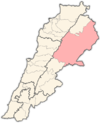Qaa
Qaa
القاع El Qaa, Al Qaa | |
|---|---|
UTC+2 (EET) | |
| • Summer (DST) | +3 |
| Alternative name | El Qaa |
|---|---|
| Location | Beqaa Valley, Lebanon |
| Part of | Type site |
| History | |
| Periods | Shepherd Neolithic |
| Site notes | |
| Archaeologists | M. Billaux, Henri Fleisch |
| Condition | ruins |
| Public access | Yes |

Qaa (
Lebanese Maronites
History
In 1838, Eli Smith noted Qaa's population as being predominantly Catholic Christian.[3]
On June 28, 1978, unidentified militiamen killed twenty-six villagers from Qaa and three other villages. The murders were believed to be connected to the killing of thirty-four people, including
Tony Franjieh, on 13 June. The gunmen were reported to have had lists of names from which they selected their victims.[4]
The
Syrian army invaded Lebanon at 4 a.m. on 1 September 2012 and kidnapped a farmer from the town as part of escalating incursions during the Syrian civil war. The invasion lasted for forty minutes before the unit withdrew. A house in Qaa had previously been hit by a shell fired by the Syrian army.[5]
On the 27 June 2016, at least
Archaeology
Along with
Maqne I, Qaa is a type site of the Shepherd Neolithic industry. The site is located 5 miles (8 km) north west of the town, north of a path leading from Qaa to Hermel. It was discovered by M. Billaux and the materials recovered were documented by Henri Fleisch in 1966.[9] The area was lightly cultivated with a thin soil covering the conglomerates. The flints were divided into three groups of a reddish brown, light brown and one that was mostly chocolate and grey colored with a radiant "desert shine".[2]
The Shepherd Neolithic industry can be defined firstly by being small and thick in size, with
Lebanese civil war
.
See also
References
- ^ "The Forgotten Turks: Turkmens of Lebanon" (PDF). Centre for Middle Eastern Strategic Studies. Feb 2010. Archived from the original (PDF) on March 3, 2016. Retrieved May 8, 2015.
- ^ a b c L. Copeland; P. Wescombe (1966). Inventory of Stone-Age Sites in Lebanon: North, South and East-Central Lebanon, p. 49. Impr. Catholique. Retrieved 29 August 2011.
- ^ Robinson and Smith, 1841, vol 3, 2nd appendix, p. 144
- ^ "Lebanese Christians Are Slain by Gunmen". The New York Times. 29 June 1978.
- ^ "Syrian army crosses into Lebanon, snatches farmer". The Daily Star (Lebanon).
- ^ "Lebanon: Christian village hit by multiple suicide attacks". BBC News. 27 June 2016.
- ^ "Suicide bombers strike Lebanese village, kill five". U.S. 27 June 2016 – via Reuters.
- ^ Andrew Doran (28 June 2016). "ISIS in Lebanon: The courage of a Christian town on the frontline of Jihad". Newsweek.
- ^ Fleisch, Henri., Notes de Préhistoire Libanaise : 1) Ard es Saoude. 2) La Bekaa Nord. 3) Un polissoir en plein air. BSPF, vol. 63, 1966.

